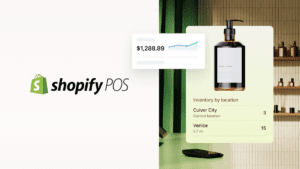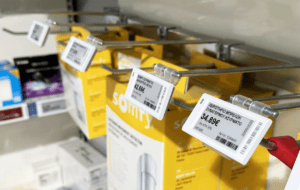
Dans le paysage moderne de la vente au détail, la convergence du commerce électronique et des magasins n’est plus facultative, elle est essentielle. Les consommateurs d’aujourd’hui s’attendent à une expérience transparente, qu’ils fassent leurs achats en ligne ou en magasin. Ils veulent des prix cohérents, des promotions synchronisées et des mises à jour des stocks en temps réel à chaque point de contact. Cette attente introduit l’un des défis les plus persistants de la vente au détail omnicanale : gérer efficacement les prix et les promotions entre une boutique en ligne et un magasin physique.
Les détaillants qui utilisent Shopify POS sont particulièrement bien placés pour offrir une expérience client unifiée, mais la synchronisation des prix et des promotions en temps réel entre les vitrines numériques et physiques reste un obstacle opérationnel important. Cet article explore les complexités des défis de la tarification omnicanale et la façon dont les technologies innovantes telles que les étiquettes électroniques de rayon (ESL) peuvent révolutionner la synchronisation des prix pour les propriétaires/exploitants.
L’importance de la cohérence des prix en temps réel
Une étude réalisée en 2022 par Retail TouchPoints a révélé que 61 % des acheteurs ont été frustrés par l’incohérence des prix entre les canaux en ligne et en magasin. Plus de 79 % des clients s’attendent à ce que les prix et les promotions soient identiques, quel que soit l’endroit où ils font leurs achats. Ces attentes signifient que même des écarts mineurs peuvent éroder la confiance des clients et nuire à la réputation de la marque.
Le maintien de la cohérence des prix en temps réel entre les plateformes n’est pas seulement une question de satisfaction du client, c’est une question de survie sur un marché concurrentiel. Pourtant, les détaillants sont confrontés à des systèmes fragmentés, à des flux de travail manuels et à des décalages entre les plateformes de commerce électronique et les magasins physiques.
Shopify POS : Une base pour le commerce unifié
Shopify POS permet aux commerçants de gérer leurs boutiques en ligne et physiques dans un seul et même système. Grâce à la centralisation des stocks, des données clients et du traitement des paiements, il s’agit d’un outil puissant pour rationaliser les opérations omnicanales. Les commerçants peuvent gérer les prix et les remises via le back-office de Shopify et appliquer ces règles à la fois au commerce électronique et aux systèmes en magasin.
Cependant, même avec les intégrations transparentes de Shopify, l’exécution dans le monde réel se heurte souvent à des obstacles. Les promotions lancées sur le site de commerce électronique peuvent ne pas se refléter instantanément dans les rayons des magasins physiques. Le personnel doit mettre à jour manuellement les étiquettes de prix en papier ou la signalétique, une tâche qui prend du temps et qui est sujette à des erreurs. Lorsque les prix changent fréquemment (par exemple, lors de ventes flash, de remises saisonnières ou de prix compétitifs), le maintien de la synchronisation devient un travail à plein temps.
Le problème de la mise à jour manuelle des prix
La mise à jour des étiquettes de prix physiques n’est pas seulement fastidieuse, elle est aussi risquée. Selon une étude de McKinsey, les erreurs manuelles dans la fixation des prix entraînent une perte de marge brute de 5 % par an pour les détaillants. Les erreurs peuvent aller d’étiquettes de prix périmées à une signalisation promotionnelle manquante, ce qui peut entraîner.. :
- Contestations des clients lors du paiement
- Perte de ventes due à des promotions inadaptées
- Questions de conformité juridique et réglementaire
- Heures de travail perdues et inefficacité opérationnelle
Pour les détaillants qui exploitent plusieurs sites ou des magasins de grande taille, ces problèmes s’aggravent de façon exponentielle. Bien que Shopify POS puisse automatiser la tarification numérique, la déconnexion avec l’affichage physique des prix reste un problème majeur.
Saisir les étiquettes électroniques de rayonnage (ESL)

Les étiquettes électroniques de rayon (ESL) sont des affichages numériques sans fil qui remplacent les étiquettes de prix traditionnelles en papier. Contrôlées à distance, les étiquettes électroniques peuvent être synchronisées avec Shopify POS pour afficher en temps réel les prix, les promotions et les informations sur les produits directement sur les étagères.
Les avantages de l’anglais langue seconde dans la tarification omni-canal :
- Mises à jour des prix en temps réel :
- Les ESL peuvent être mis à jour instantanément à partir du tableau de bord de Shopify. Qu’il s’agisse de lancer une promotion, d’ajuster les prix en fonction des tendances du marché ou de réagir aux prix des concurrents, les changements peuvent être répercutés en quelques secondes sur tous les sites.
- Élimine les erreurs manuelles :
- Fini les étiquettes manquantes ou les prix incohérents entre les caisses et les rayons. Les ESL affichent des informations précises et actualisées provenant directement de votre système de point de vente.
- Promotions dynamiques :
- Les ESL peuvent être programmés pour refléter des promotions temporaires, des prix groupés, des offres BOGO ou des prix de fidélité. Ils peuvent être activés automatiquement en fonction de règles prédéfinies dans Shopify.
- Efficacité opérationnelle :
- Le personnel est libéré de la tâche répétitive de remplacement des étiquettes papier, ce qui lui permet de se concentrer sur le service à la clientèle et l’engagement en magasin.
- Amélioration de l’expérience client :
- Les clients bénéficient d’une tarification plus claire et plus cohérente. Les ASP peuvent également afficher des détails supplémentaires sur les produits, des codes QR renvoyant à des commentaires en ligne ou à la disponibilité des stocks.
- Réduction des coûts au fil du temps :
- Si les ESL nécessitent un investissement initial, les économies réalisées à long terme grâce à la réduction de la main-d’œuvre et à l’amélioration de la précision des prix permettent un retour sur investissement important.
- Gain de temps pour les propriétaires/exploitants :
- La plupart du temps, les propriétaires et les exploitants de magasins de détail qui utilisent Shopify POS sont des entrepreneurs indépendants qui n’ont tout simplement pas le temps d’effectuer des changements d’étiquettes de prix sur papier à l’étalage. En investissant dans des ALS, ils libèrent un temps considérable qu’ils peuvent réorienter vers des tâches à forte valeur ajoutée telles que le merchandising, le marketing, le service client ou la planification stratégique. Le retour sur investissement ne doit pas seulement prendre en compte les économies de coûts de main-d’œuvre, mais aussi la valeur accrue du temps du propriétaire et sa capacité à faire évoluer son entreprise plus efficacement.
- Augmentation des ventes grâce à des promotions plus fréquentes :
- Les ESL facilitent l’organisation de promotions plus fréquentes et en temps réel. Cela peut entraîner une augmentation du chiffre d’affaires jusqu’à 10 %, car les produits peuvent être réduits ou mis en valeur à des moments optimaux pour augmenter les ventes et le montant des paniers.
Quantifier l’impact
Les chiffres sont éloquents :
- Selon une étude réalisée par Deloitte en 2023, les détaillants qui ont recours à l’anglais langue seconde ont réduit leurs coûts de main-d’œuvre jusqu’à 70 %.
- Les détaillants qui ont mis en place des ESL avec synchronisation en temps réel ont constaté une augmentation de 23 % de la conformité des promotions dans l’ensemble des magasins.
- Une étude de cas menée par une chaîne de supermarchés européenne a montré que l’utilisation d’ESL a permis de réduire les erreurs de tarification de 90 % et d’augmenter le taux de satisfaction des clients de 15 %.
Calculateur de retour sur investissement : Analyse de rentabilité de l’investissement dans l’ESL
| Catégorie coût/bénéfice | Montant estimé (annuel) |
|---|---|
| Nombre de produits par magasin | 2,000 |
| Délai de mise à jour de l’étiquette papier par produit | 30 secondes |
| % de produits mis à jour chaque semaine | 25% (500 articles) |
| Temps de travail hebdomadaire (étiquettes manuelles) | 250 minutes (4,17 heures) |
| Temps annuel passé | 13 000 minutes (~217 heures) |
| Coût horaire de la main-d’œuvre | 18 $/heure |
| Coût annuel de la main-d’œuvre pour les changements de prix | ~$3,906 |
| Investissement initial dans le système ESL (1 fois) | 25 000 $ – 30 000 $ (en fonction de la taille) |
| Maintenance annuelle du système ESL | ~$2,000 |
| Valeur du temps du propriétaire/opérateur (200 $/heure) | ~43 400 $ de coût d’opportunité |
| Réduction de la perte de marge liée à l’erreur | Augmentation de la marge de 3 à 5 % grâce à une meilleure précision |
| Augmentation potentielle du chiffre d’affaires | Jusqu’à 10 % avec des promotions plus fréquentes |
| Période de récupération | 12 à 18 mois (en moyenne) |
Ces estimations mettent en évidence la manière dont les ASP peuvent générer des retours opérationnels et financiers significatifs, en particulier pour les propriétaires/exploitants dont le temps est compté. La valeur intangible la plus importante est le temps : plus d’heures consacrées à la stratégie, à l’engagement des clients et au développement de l’entreprise au lieu de la mise à jour manuelle des rayons.
Intégrer les ALS aux points de vente Shopify

Shopify POS est compatible avec un logiciel intermédiaire tiers qui relie les systèmes ESL à votre système Shopify. Cela vous permet de :
- Synchronisation automatique des modifications de prix et de produits entre Shopify et ESLs
- Programmer des mises à jour de prix ou des promotions ponctuelles
- Déclencher des modifications de l’ESL en fonction des niveaux de stock, de l’heure de la journée ou des segments de clientèle
Les commerçants peuvent choisir parmi les principaux fournisseurs d’ESL dont les plateformes offrent des API robustes et une compatibilité plug-and-play avec le système dorsal de Shopify. Les ingénieurs peuvent établir des correspondances entre les UGS des produits Shopify et les ESL, ce qui permet une automatisation complète.
Étude de cas : Exemple de transformation d’un marchand Shopify
Prenons l’exemple d’un détaillant de vêtements de taille moyenne qui exploite trois magasins et un site de commerce électronique Shopify. Avant la mise en place des ESL, la mise à jour des prix pour les nouvelles promotions nécessitait plus de 20 heures de travail manuel par semaine. Les écarts de prix entraînaient des réclamations fréquentes de la part des clients, des abandons de caisses et la confusion du personnel.
Après l’intégration d’ESLs avec Shopify POS :
- Les mises à jour promotionnelles ont été synchronisées en moins d’une minute dans tous les magasins.
- Les erreurs de tarification sont passées de 15 % à moins de 0 %.
- Les taux de conversion en magasin ont augmenté de 12 % grâce à une meilleure transparence des prix.
- Les coûts de main-d’œuvre liés à la tarification ont été réduits de 98 %.
Ce commerçant exploite désormais une activité de vente au détail plus légère et plus souple, où la stratégie de prix et l’exécution sont parfaitement alignées.
Étude de cas : Pascal Maynard – La boutique mythique avec Shopify POS
Le magasin Mythic est un détaillant spécialisé qui exploite un magasin en dur et un site de commerce électronique utilisant Shopify POS. Avant la mise en place des ESL, la mise à jour des prix pour les nouvelles promotions nécessitait plusieurs heures de travail manuel par semaine. Les écarts de prix entraînaient une frustration fréquente des clients, des opportunités de vente manquées et une réduction de la qualité de vie du propriétaire/exploitant.
Après que Pascal Maynard soit passé aux ESL avec Shopify POS :
- Il est essentiel d’améliorer l’efficacité du traitement des bons de commande en éliminant la nécessité de fixer le prix des articles individuellement ou de modifier les étiquettes physiques sur les étagères.
- Les mises à jour horaires des étiquettes électroniques de rayonESL permettent de maintenir les prix à jour, ce qui réduit le temps nécessaire pour effectuer ces mises à jour manuellement au cours d’une semaine. En outre, l’affichage des quantités aide le personnel à déterminer s’il convient d’apporter davantage de produits de l’arrière-boutique.
- Les différents modèles ESL permettent aux clients et au personnel d’identifier rapidement les articles en rupture de stock, les remises et d’autres informations importantes sur les produits.
« L’intégration des ATI ESL dans notre entreprise a permis de rationaliser de nombreux processus et nous a déjà fait gagner un nombre incalculable d’heures de travail. Bien qu’il s’agisse d’un investissement initial, il est très facile de calculer le nombre d’heures économisées au cours de la première année, ce qui en fait un investissement très rentable. «
-Pascal Maynard, The Mythic Store
Surmonter les difficultés de mise en œuvre
Bien que les ASP offrent des avantages transformateurs, les propriétaires/exploitants doivent tenir compte de plusieurs facteurs :
- Investissement initial :
- Les ESL nécessitent des dépenses initiales pour le matériel et l’intégration, mais les options de location et les remises sur volume peuvent atténuer les coûts.
- Intégration du système :
- Travaillez avec des ingénieurs expérimentés pour vous assurer que les ESLs se synchronisent correctement avec Shopify POS. Il est essentiel de cartographier les UGS des produits et d’automatiser les règles.
- Formation du personnel :
- Former le personnel à l’interprétation des indicateurs de ESL , à la résolution des erreurs et à l’utilisation du système pour les promotions.
- Cohérence de la conception :
- Concevoir des étiquettes numériques pour maintenir la cohérence de la marque et maximiser la lisibilité. La plupart des plateformes ESL proposent des modèles personnalisables.
L’avantage concurrentiel
Dans un environnement de vente au détail où 73 % des clients achètent à la fois en ligne et en magasin, la cohérence des prix n’est pas seulement une bonne pratique, c’est une nécessité concurrentielle. Les ESL permettent aux marchands Shopify de combler l’écart de prix et de créer une véritable expérience omnicanale.
Les détaillants qui investissent dans une infrastructure de tarification en temps réel, comme les ESL, y gagnent :
- Satisfaction accrue des clients
- Réduction des frais généraux opérationnels
- Une plus grande agilité promotionnelle
- Amélioration de la perception de la marque
- Plus de temps pour les travaux stratégiques à forte valeur ajoutée des propriétaires/exploitants
- Augmentation des ventes grâce à une tarification et à des promotions plus dynamiques
Réflexions finales
La vente au détail omni-canal ne se limite pas à un site Web et à une vitrine. Elle exige une synchronisation transparente de tous les éléments en contact avec le client, en particulier la tarification. Pour les commerçants qui utilisent Shopify POS, il est essentiel de pouvoir aligner les prix en temps réel entre les espaces numériques et physiques.
Les étiquettes électroniques de rayon constituent une solution puissante et évolutive à l’un des problèmes les plus frustrants de la vente au détail. En automatisant les mises à jour de prix et en s’intégrant directement à Shopify, les ESL éliminent les inefficacités manuelles, améliorent l’expérience client et ouvrent la voie à une vente au détail plus intelligente.
À l’ère des attentes instantanées, les détaillants ne peuvent plus se permettre des retards ou des écarts de prix. Les ESL, combinés à Shopify POS, offrent l’intelligence opérationnelle nécessaire pour être compétitif – et gagner – dans un monde véritablement omnicanal.
Prochaines étapes
Pour explorer les avantages que les ALS peuvent apporter à votre commerce de détail ou pour planifier une consultation, communiquez avec notre équipe dès aujourd’hui. Nous nous engageons à vous aider à transformer vos opérations en magasin et à profiter des avantages de cette technologie novatrice. Nos experts peuvent fournir une évaluation personnalisée de vos besoins et vous guider tout au long du processus de mise en œuvre, en veillant à ce que vous tiriez le meilleur parti de votre investissement dans les ALS. Laissez-nous vous aider à franchir la prochaine étape vers des opérations de vente au détail plus intelligentes et plus efficaces.




